MD-MAC: A Distributed TDMA Protocol Based on Desynchronization for Multi-Hop Topologies
Abstract
1. Introduction
- The protocol we design is a totally distributed protocol, which does not rely on the prior knowledge of nodes(for instance, the busy time slots or the whole topology), and requires neither central node to negotiate or the global information.
- Solving the problem of stale information, namely communication delay between each node, which makes the DESYNC process feasible in multi-hop networks.
- A collision detection scheme is proposed, which can avoid collisions caused by topology change or multiple network mergence after the network converge.
2. System Model and Problem Definition
2.1. Desynchronization Process
2.2. MD-MAC System Model
3. Algorithm Description
The Process of MD-MAC
- and are one-hop neighbors of :In this case, the same as the Desync-MAC protocol. Whatever the time stamp is, adjusts its phase to the midpoint of and while of the after node is equal to 1, which means that has stored the current information of its neighbors.
- Either of or is one-hop neighbor of in the topology, and another is two-hop:In this case, only if phase of ’s one-hop neighbor is to 1 and its time stamp is equal to the two-hop node or , starts to adjust.
- Both of and are two-hop neighbor of :In this case, the rule is that starts to adjust only when the phase of minimum node of ’s on-hop neighbor is set to 1 and both of neighbors’ time stamp and are equal to .
| Algorithm 1 The Process of MD-MAC. |
|
4. Implementation Issues
4.1. Stability of the Desynchronization Process
4.2. Self-Adaptation of MD-MAC
4.2.1. One-Hop Collision
4.2.2. Two-Hop Collision
5. Evaluation
5.1. Example of the MD-MAC Operation
5.2. Convergence Speed
5.3. Throughput
5.4. Convergence Speed of Collision Avoidance
6. Conclusions
Author Contributions
Funding
Conflicts of Interest
References
- Iannello, F.; Simeone, O.; Spagnolini, U. Medium access control protocols for wireless sensor networks with energy harvesting. IEEE Trans. Commun. 2012, 60, 1381–1389. [Google Scholar] [CrossRef]
- Fafoutis, X.; Di Mauro, A.; Orfanidis, C.; Dragoni, N. Energy-efficient medium access control for energy harvesting communications. IEEE Trans. Consum. Electron. 2015, 61, 402–410. [Google Scholar] [CrossRef]
- Mutazono, A.; Sugano, M.; Murata, M. Frog call-inspired self-organizing anti-phase synchronization for wireless sensor networks. In Proceedings of the 2009 2nd International Workshop on Nonlinear Dynamics and Synchronization, Klagenfurt, Austria, 20–21 July 2009; pp. 81–88. [Google Scholar]
- Nisioti, E.; Thomos, N. Fast reinforcement learning for decentralized MAC optimization. arXiv 2018, arXiv:1805.06912. [Google Scholar]
- Li, C.; Zhang, H.; Hao, B.; Li, J. A survey on routing protocols for large-scale wireless sensor networks. Sensors 2011, 11, 3498–3526. [Google Scholar] [CrossRef] [PubMed]
- Sgora, A.; Vergados, D.J.; Vergados, D.D. A survey of TDMA scheduling schemes in wireless multihop networks. ACM Comput. Surv. (CSUR) 2015, 47, 53. [Google Scholar] [CrossRef]
- Rhee, I.; Warrier, A.; Min, J.; Xu, L. DRAND: Distributed randomized TDMA scheduling for wireless ad hoc networks. IEEE Trans. Mob. Comput. 2009, 8, 1384–1396. [Google Scholar] [CrossRef]
- Li, Y.; Zhang, X.; Zeng, J.; Wan, Y.; Ma, F. A distributed TDMA scheduling algorithm based on energy-topology factor in Internet of Things. IEEE Access 2017, 5, 10757–10768. [Google Scholar] [CrossRef]
- Bryan, K.L.; Ren, T.; DiPippo, L.; Henry, T.; Fay-Wolfe, V. Towards Optimal Tdma Frame Size in Wireless Sensor Networks; Technical Report; University of Rhode Island: South Kingstown, Rhode Island, 2007. [Google Scholar]
- Liu, Y.; Li, V.O.; Leung, K.C.; Zhang, L. Topology-transparent scheduling in mobile ad hoc networks with multiple packet reception capability. IEEE Trans. Wirel. Commun. 2014, 13, 5940–5953. [Google Scholar] [CrossRef]
- Chang, C.J.; Wu, C.H. Optimal frame pattern design for a TDMA mobile communication system using a simulated annealing algorithm. IEEE Trans. Veh. Technol. 1993, 42, 205–211. [Google Scholar] [CrossRef]
- Mao, J.; Wu, Z.; Wu, X. A TDMA scheduling scheme for many-to-one communications in wireless sensor networks. Comput. Commun. 2007, 30, 863–872. [Google Scholar] [CrossRef]
- Degesys, J.; Rose, I.; Patel, A.; Nagpal, R. DESYNC: Self-organizing desynchronization and TDMA on wireless sensor networks. In Proceedings of the 6th International Conference on Information Processing in Sensor Networks, Cambridge, MA, USA, 25–27 April 2007; pp. 11–20. [Google Scholar]
- Kim, K.; Shin, S.h.; Roh, B.h. Firing Offset Adjustment of Bio-Inspired DESYNC-TDMA to Improve Slot Utilization Performances in Wireless Sensor Networks. TIIS 2017, 11, 1492–1509. [Google Scholar]
- Mühlberger, C.; Kolla, R. Extended Desynchronization for Multi-Hop Topologies. Available online: https://www.informatik.uni-wuerzburg.de/fileadmin/10030500/user_upload/staff/muehlberger/Extended_Desynchronization_for_Multi-Hop_Topologies__TR_460_.pdf (accessed on 20 November 2019).
- Rhee, I.; Warrier, A.; Aia, M.; Min, J.; Sichitiu, M.L. Z-MAC: A hybrid MAC for wireless sensor networks. IEEE/ACM Trans. Netw. 2008, 16, 511–524. [Google Scholar] [CrossRef]
- Zhao, H.; Wei, J.; Sarkar, N.I.; Huang, S. E-MAC: An evolutionary solution for collision avoidance in wireless ad hoc networks. J. Netw. Comput. Appl. 2016, 65, 1–11. [Google Scholar] [CrossRef][Green Version]
- He, J.; Cheng, P.; Shi, L.; Chen, J.; Sun, Y. Time synchronization in WSNs: A maximum-value-based consensus approach. IEEE Trans. Autom. Control 2013, 59, 660–675. [Google Scholar] [CrossRef]
- Ceriotti, M.; Murphy, A.L. Reins-MAC: Firefly Inspired Communication Scheduling for Reliable Low-Power Wireless. In Proceedings of the 2018 IEEE 12th International Conference on Self-Adaptive and Self-Organizing Systems (SASO), Trento, Italy, 3–7 September 2018; pp. 140–149. [Google Scholar]
- Fang, M.; Malone, D.; Duffy, K.R.; Leith, D.J. Decentralised learning MACs for collision-free access in WLANs. Wirel. Netw. 2013, 19, 83–98. [Google Scholar] [CrossRef]
- Barcelo, J.; Bellalta, B.; Cano, C.; Oliver, M. Learning-BEB: Avoiding Collisions in WLANs. Available online: https://www.tdx.cat/bitstream/handle/10803/7553/tjbv.pdf#page=41 (accessed on 20 November 2019).

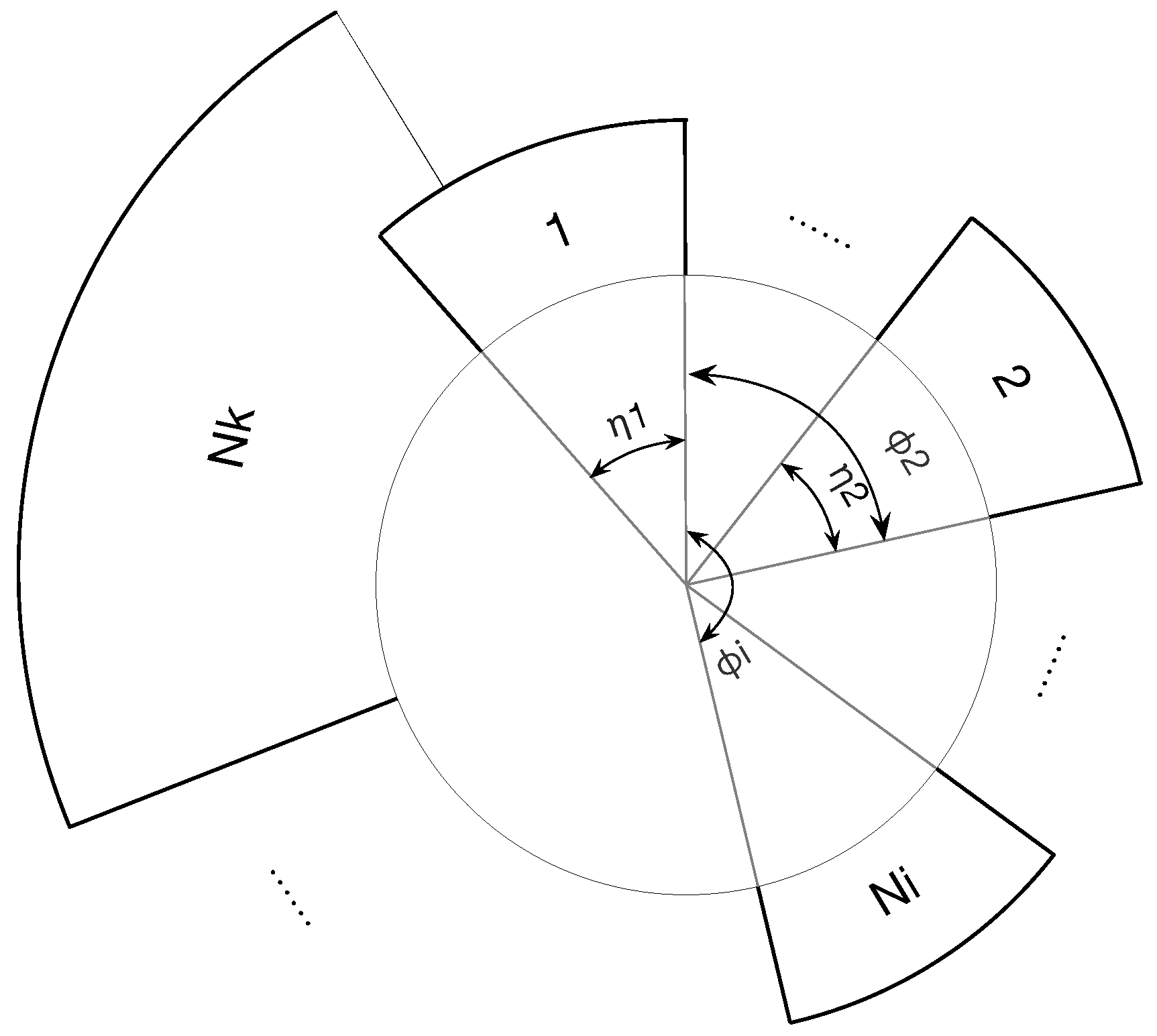
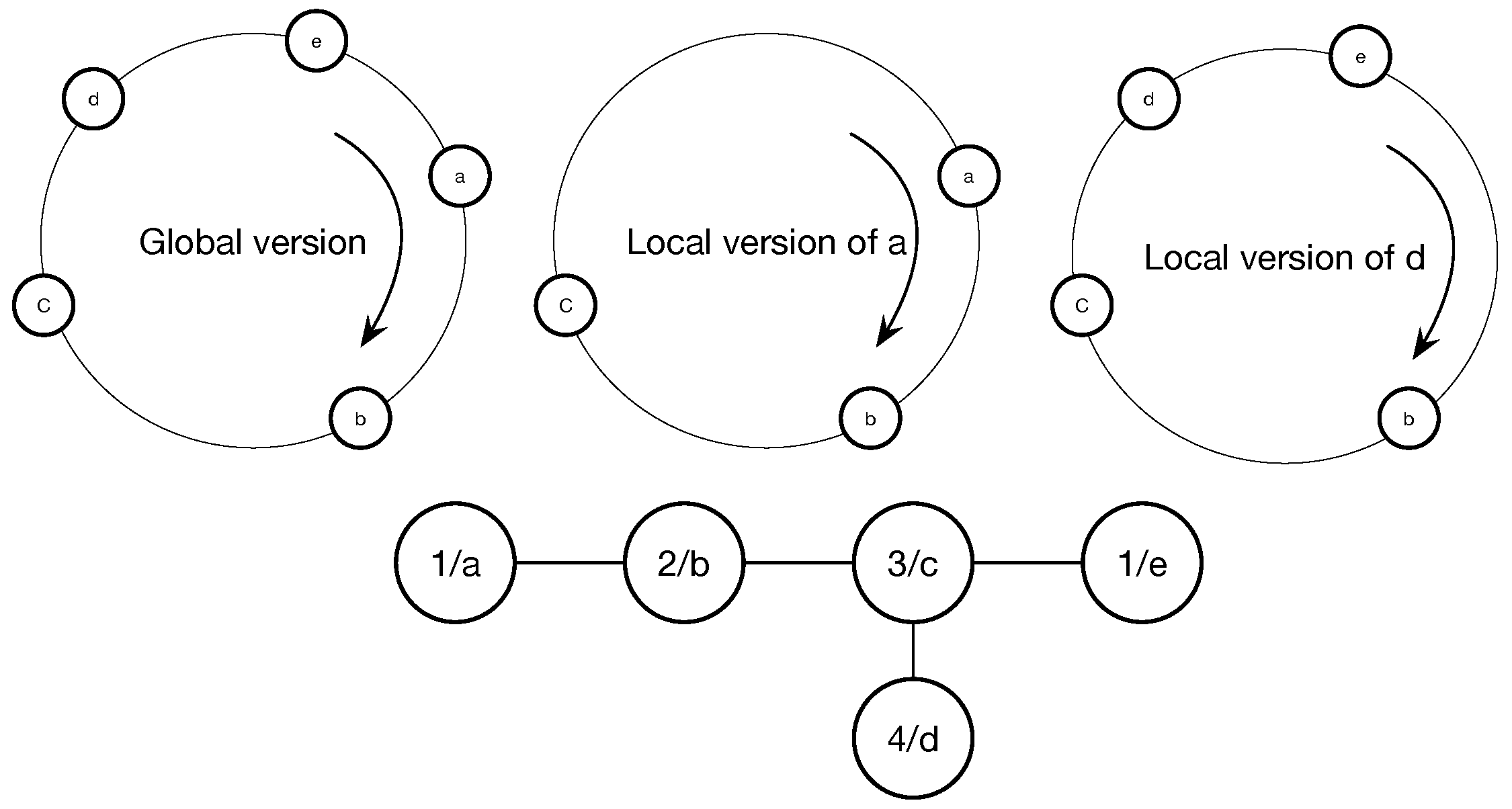
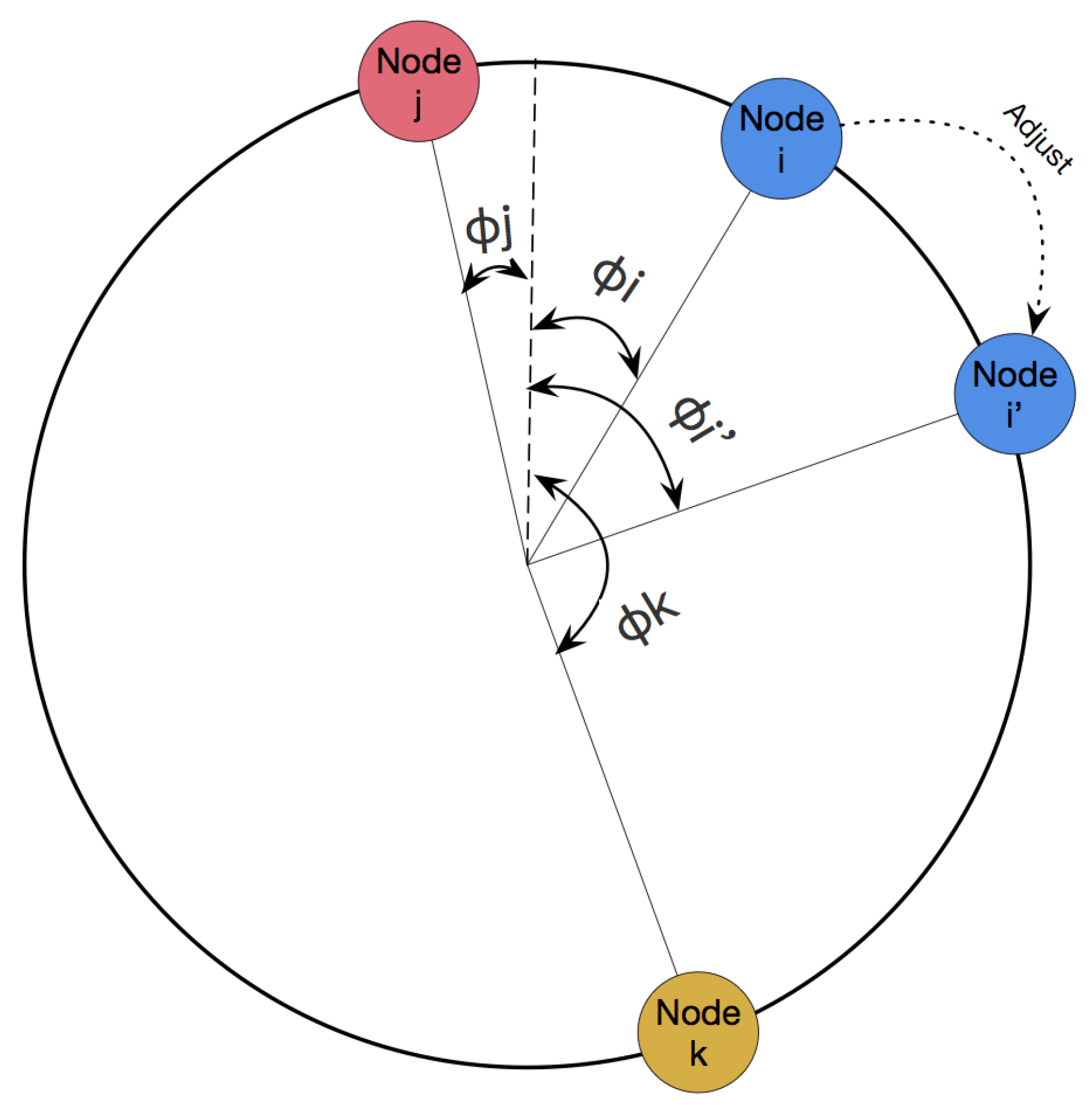
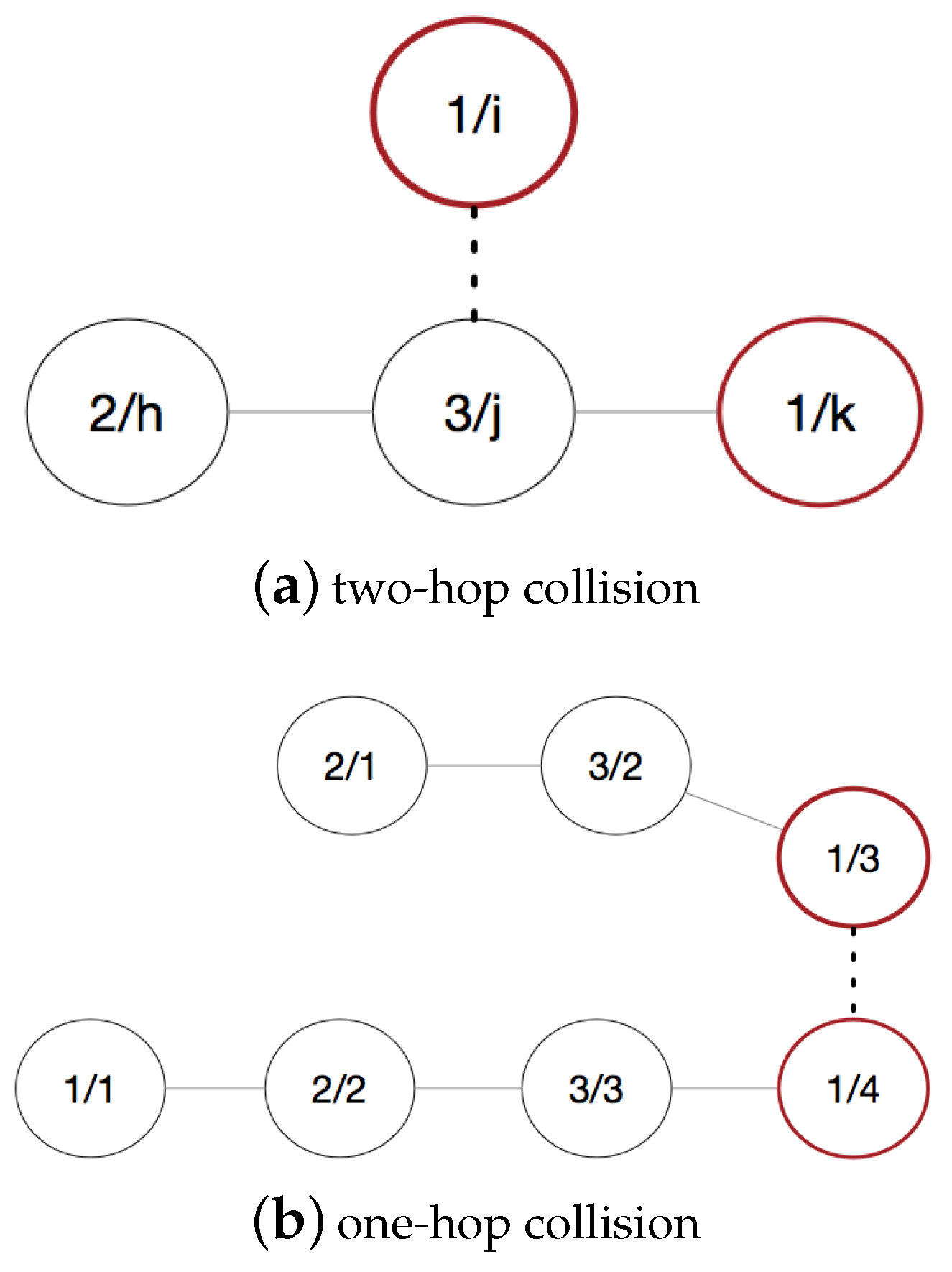

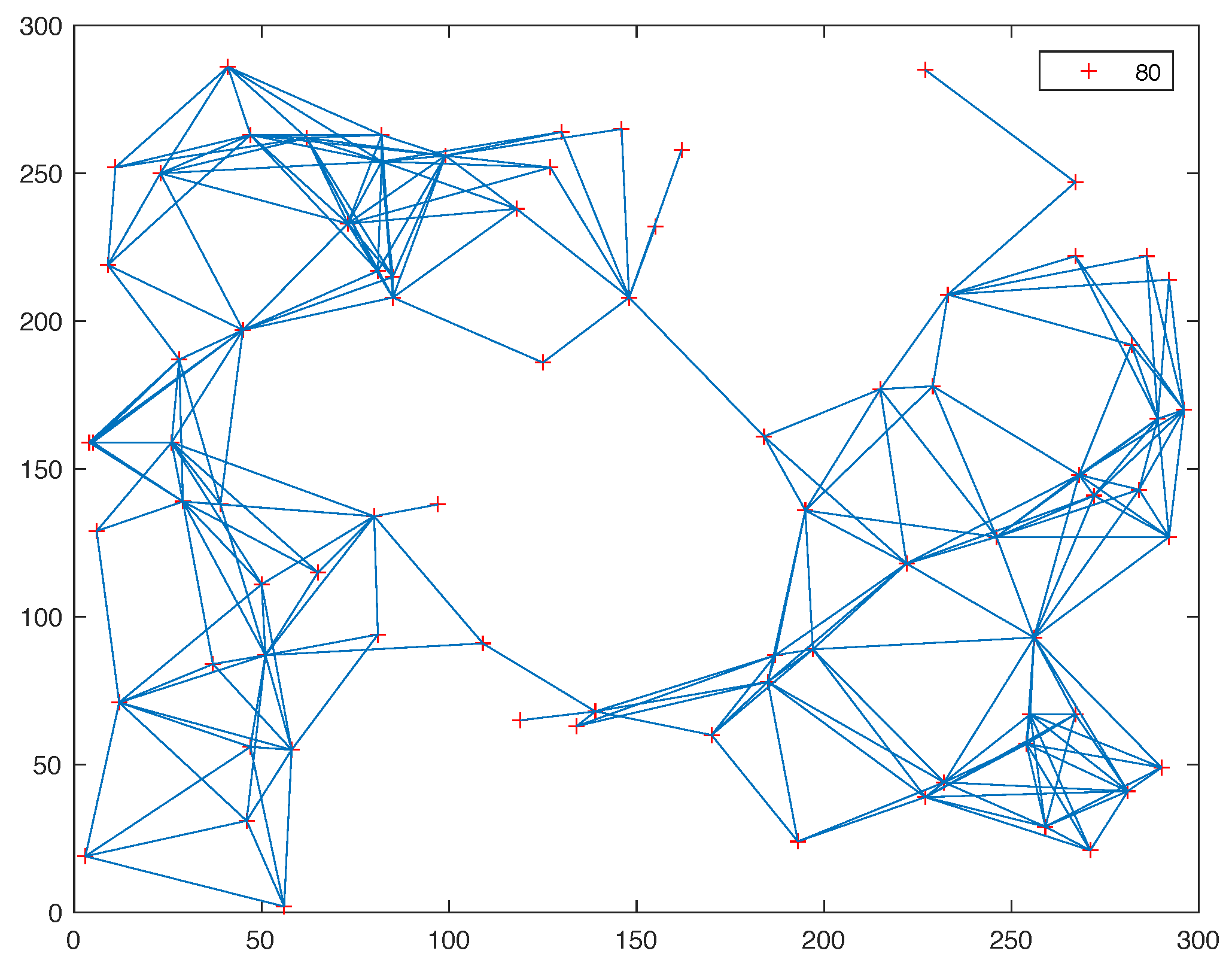
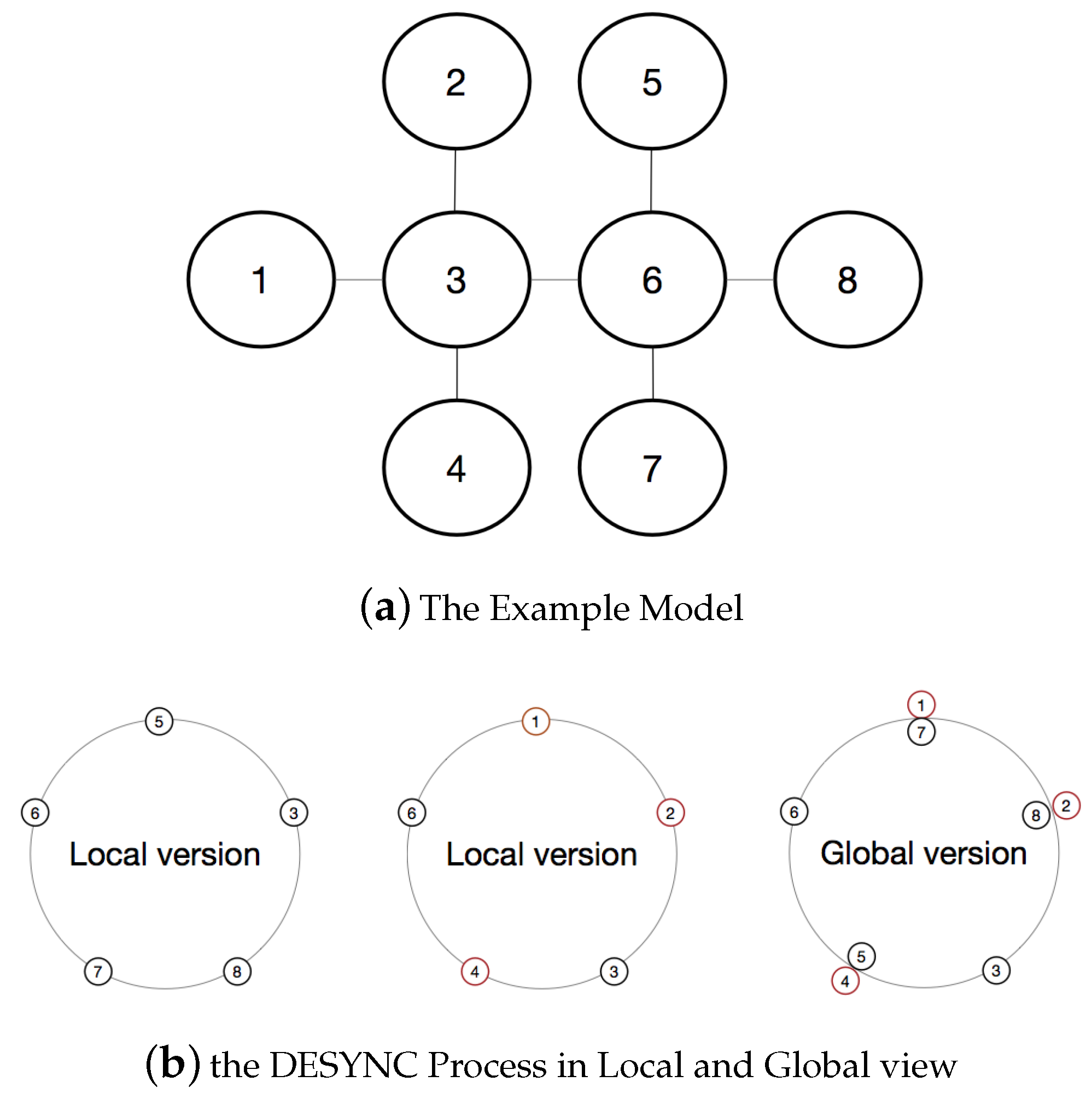
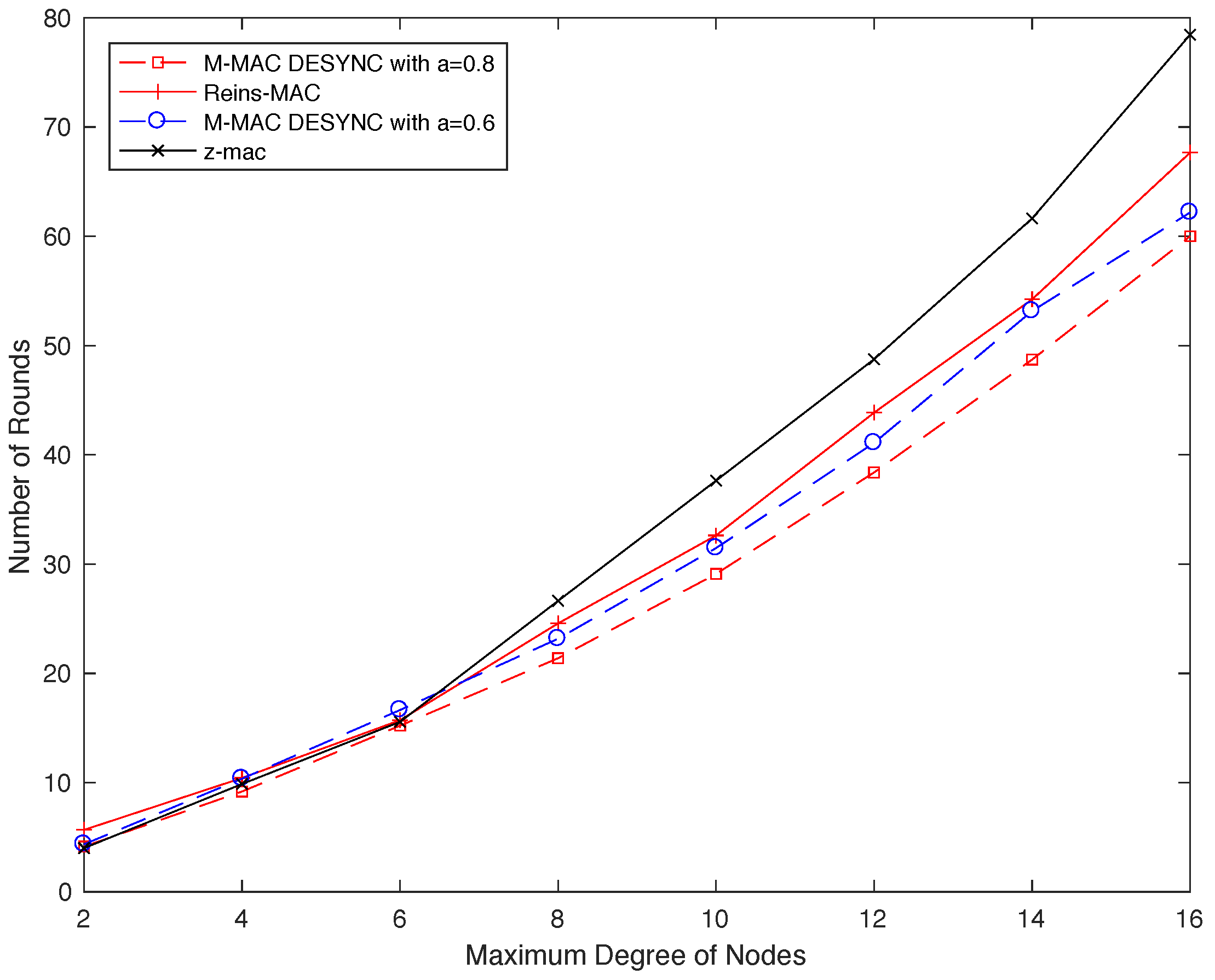
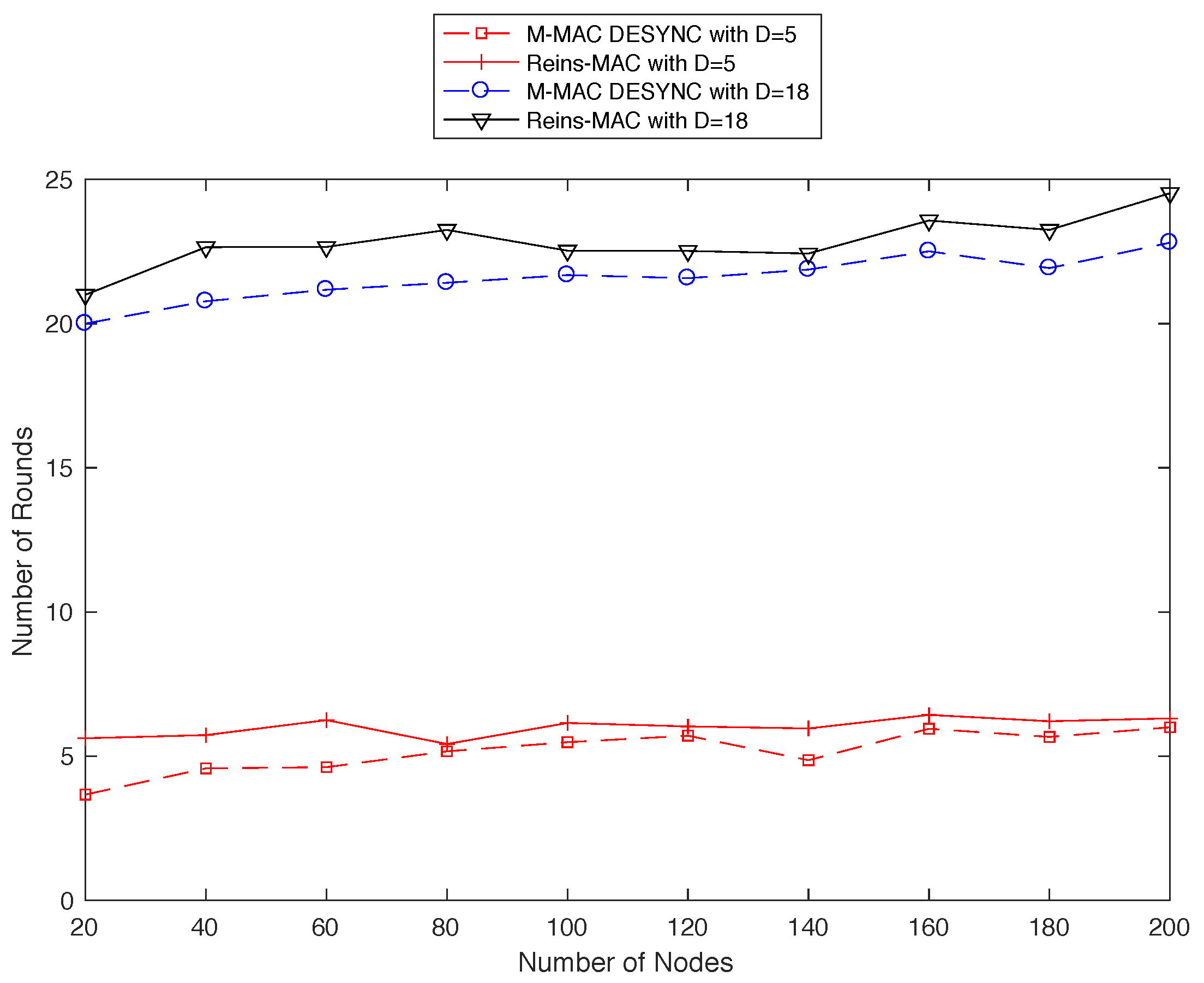
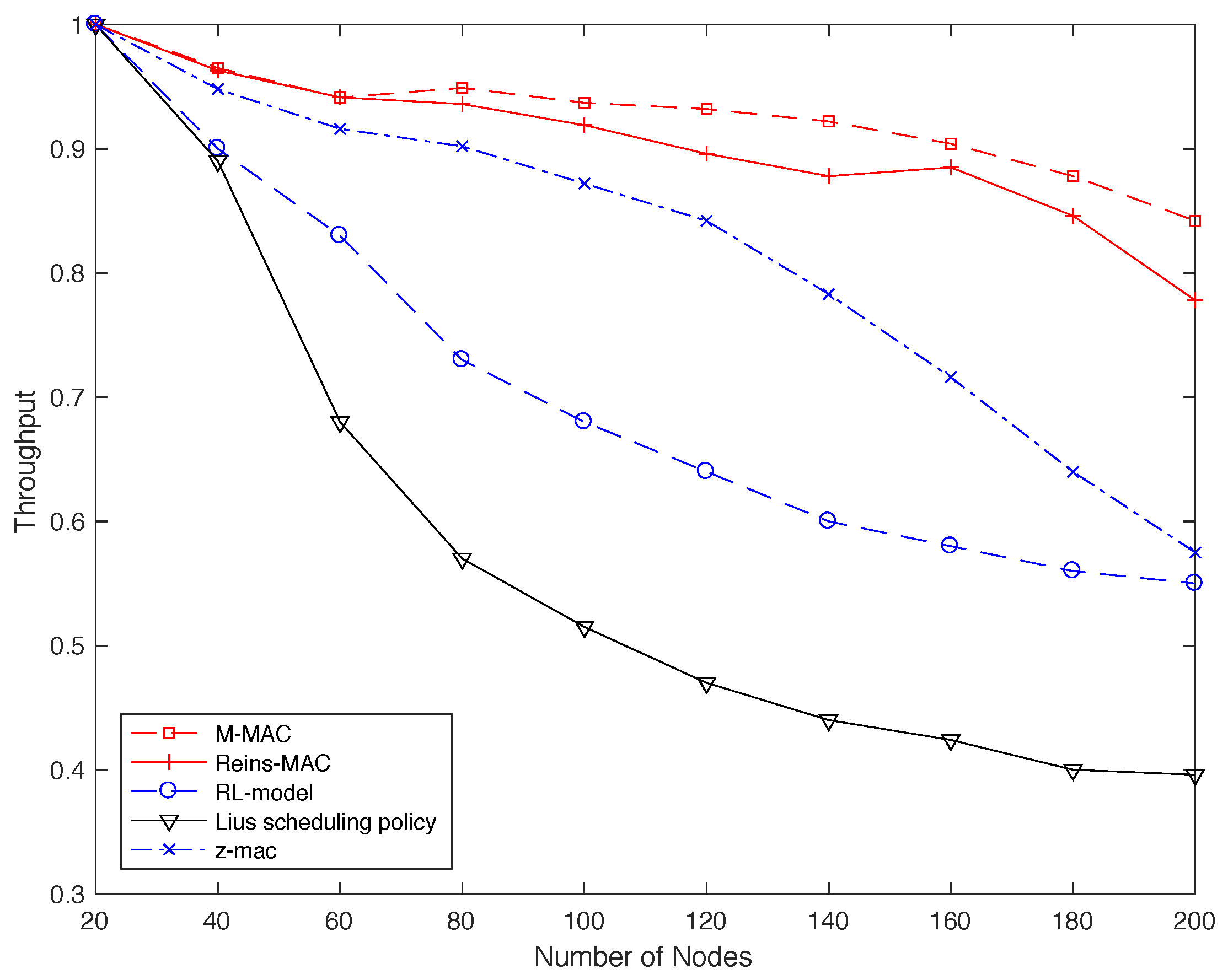
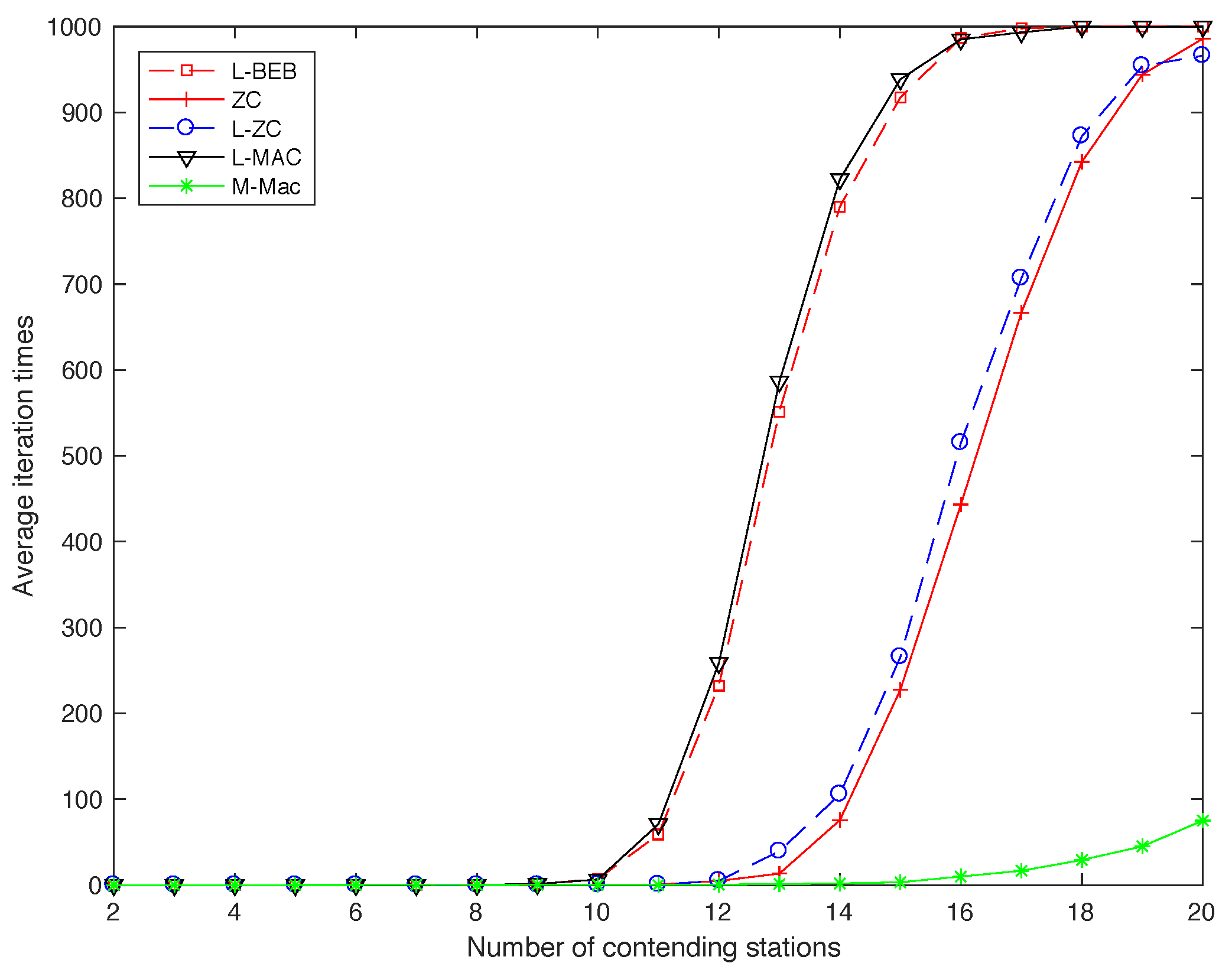
| link capacity | 2 Mbps |
| Broadcast Range | 60–120 m |
| Transmission power | 1–2 mW |
| Range of neighbor nodes | [2, 20] |
| Number of nodes | [20, 200] |
| Average transfer delay | 0.5 ms |
| The number of minimum slot | 100 |
© 2019 by the authors. Licensee MDPI, Basel, Switzerland. This article is an open access article distributed under the terms and conditions of the Creative Commons Attribution (CC BY) license (http://creativecommons.org/licenses/by/4.0/).
Share and Cite
Zheng, C.; Huang, S.; Wei, J.; Dong, Q. MD-MAC: A Distributed TDMA Protocol Based on Desynchronization for Multi-Hop Topologies. Sensors 2019, 19, 5102. https://doi.org/10.3390/s19235102
Zheng C, Huang S, Wei J, Dong Q. MD-MAC: A Distributed TDMA Protocol Based on Desynchronization for Multi-Hop Topologies. Sensors. 2019; 19(23):5102. https://doi.org/10.3390/s19235102
Chicago/Turabian StyleZheng, Chaoyi, Shengchun Huang, Jibo Wei, and Qiangjian Dong. 2019. "MD-MAC: A Distributed TDMA Protocol Based on Desynchronization for Multi-Hop Topologies" Sensors 19, no. 23: 5102. https://doi.org/10.3390/s19235102
APA StyleZheng, C., Huang, S., Wei, J., & Dong, Q. (2019). MD-MAC: A Distributed TDMA Protocol Based on Desynchronization for Multi-Hop Topologies. Sensors, 19(23), 5102. https://doi.org/10.3390/s19235102




